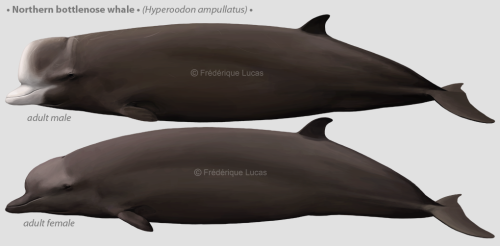#southern bottlenose whale
The Bottlenose Whales
Happy new year everyone! Sorry for the quiet, I’ve been busy finishing two big projects. One of the things I loved about both of them is how many beaked whales I got to paint! I’ve never had much chance to illustrate them, so it was high time to make up for that. And what better way to start off 2022 than with some big, thick, and CHONKY bottlenose whales?
The Northern bottlenose is the biggest - adults can reach almost 10 metres in length and weigh some 6 to 7 tons! While male beaked whales are famous for their tusks, Northern bottlenoses’ are tiny. Their huge, square heads are far more prominent, and indeed this is their choice of weapon: males will use it to headbutt each other in fights. Male Southern bottlenose whales appear quite different. Their melons are smaller and more forward facing - not quite the battering ram the northerners wear - and their bodies are completely covered in rake marks, revealing a different fighting strategy. Theirs is the traditional beaked whale way of going tusk-to-tusk. It’s been said that males can bear so many scars they look almost white from a distance.
And then comes the Longman’s beaked whale - not really a bottlenose whale pur sang, but rather a namesake based on looks. They are a surprisingly recent discovery: they were only identified in the early 2000′s! Before then mysterious tales of Southern bottlenose whales in tropical waters had intrigued scientists. Longman’s beaked whale was already known, but only from two skulls. No one knew what they looked like. It wasn’t until 2003 when two stranded whales were identified through DNA, and the species’ appearance was first described. People turned to the sightings of “tropical bottlenose whales”, and concluded they were one and the same.
It is often said Longman’s look like Southern bottlenose whales: both have a light-coloured melon. However this only goes for immature Longman’s, adults look very different. Females become uniform grey, with a lighter, often orange-tinged face. Males are more of an enigma - one study observed a few ghostly light grey animals surfacing amongst a pod. They assumed these could be adult males. Sadly I can’t find any photos besides the grainy black-and-white ones this paper holds, and to my knowledge no adult male has ever stranded. So until then their appearance (and my illustration) is something of a guess. There’s still so much to learn about these animals.
Post link



